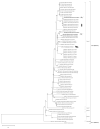Re-Emergence of a West Nile Virus (WNV) Variant in South Spain with Rapid Spread Capacity
- PMID: 38140614
- PMCID: PMC10747266
- DOI: 10.3390/v15122372
Re-Emergence of a West Nile Virus (WNV) Variant in South Spain with Rapid Spread Capacity
Abstract
West Nile Virus (WNV) is a mosquito vector-borne zoonosis with an increasing incidence in Europe that has become a public health concern. In Spain, although local circulation has been known for decades, until 2020, when a large outbreak occurred, West Nile Virus cases were scarce and mostly occurred in southern Spain. Since then, there have been new cases every year and the pathogen has spread to new regions. Thus, monitoring of circulating variants and lineages plays a fundamental role in understanding WNV evolution, spread and dynamics. In this study, we sequenced WNV consensus genomes from mosquito pools captured in 2022 as part of a newly implemented surveillance program in southern Spain and compared it to other European, African and Spanish sequences. Characterization of WNV genomes in mosquitoes captured in 2022 reveals the co-circulation of two WNV lineage 1 variants, the one that caused the outbreak in 2020 and another variant that is closely related to variants reported in Spain in 2012, France in 2015, Italy in 2021-2022 and Senegal in 2012-2018. The geographic distribution of these variants indicates that WNV L1 dynamics in southern Europe include an alternating dominance of variants in some territories.
Keywords: Culex; Spain; WNV lineage 1; flavivirus; genetic variants; vector-borne diseases; zoonosis.
Conflict of interest statement
The authors declare no conflict of interest.
Figures


References
MeSH terms
Grants and funding
LinkOut - more resources
Full Text Sources
Medical

